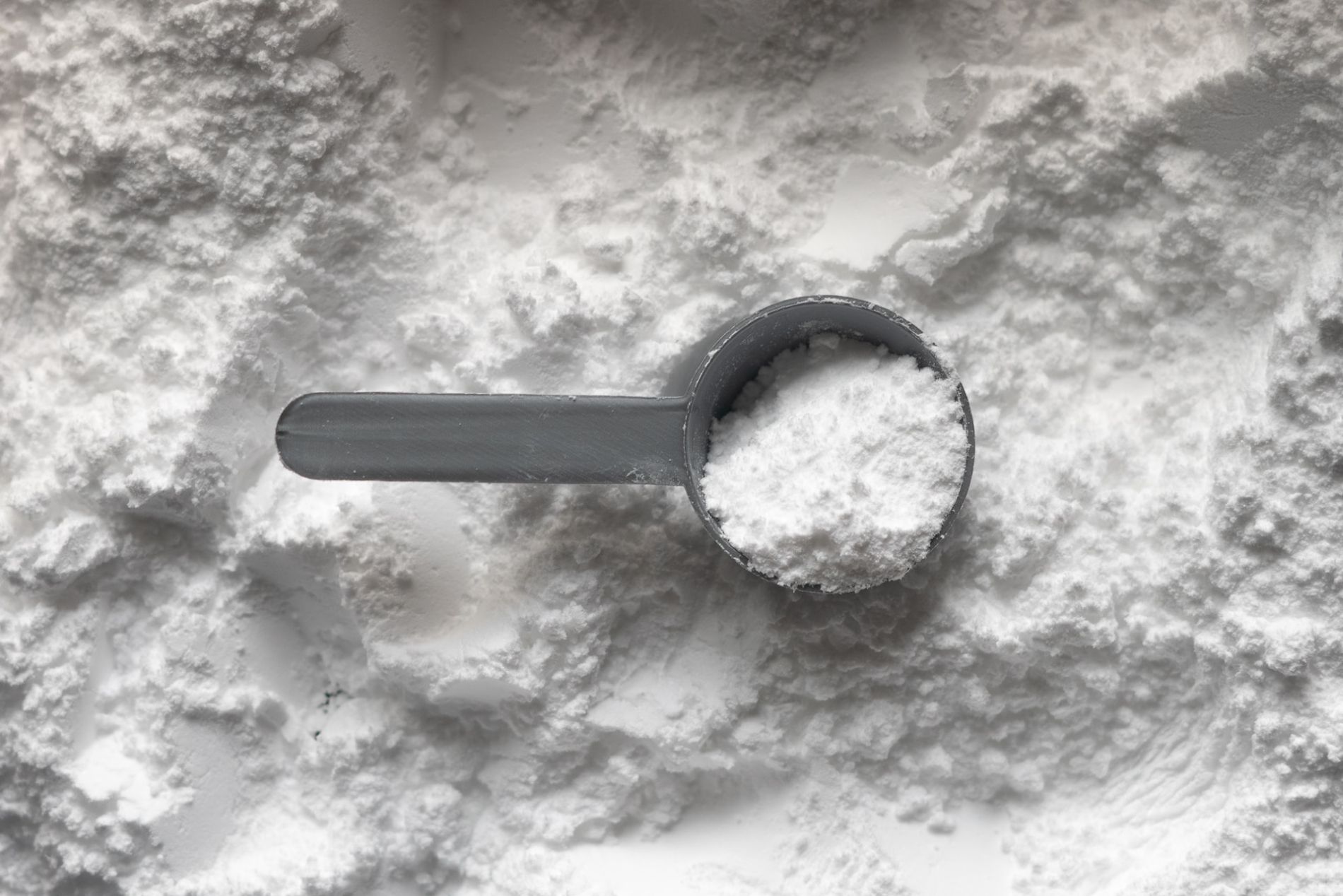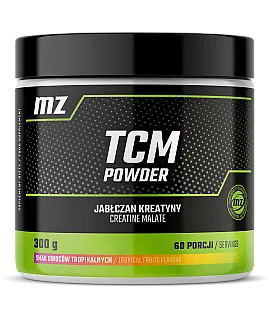Creatine malate - composition and properties

Creatine is an incredibly popular dietary supplement among professional and amateur athletes, due to its well-proven effects of increasing muscle power and strength and lean body mass. There are several types of creatine on the market of dietary supplements dedicated to athletes, and one of them is the well-known creatine malate. So let's find out what creatine malate is and what properties it exhibits.
- What is creatine malate?
- How does creatine malate work?
- Creatine malate - properties
- Creatine malate vs creatine monohydrate
- Creatine malate - dosage.
- Is creatine malate safe?
What is creatine malate?
Creatine malate (TCM) is a combination of several creatine molecules with malic acid, usually in a 3:1 or 2:1 ratio. The former combination (creatine malate 3:1) consists of nearly 75% creatine, while the latter (creatine malate 2:1) consists of 66% creatine. Creatine itself is a biologically active substance that is naturally produced in the human body, mainly in the kidneys and liver (at about 1 g per day) from such amino acids as arginine, glycine and methionine. The malic acid in creatine malate, meanwhile, is an organic chemical that leads to the release of energy from creatine in the Krebs cycle and the citric acid cycle, and increases the absorption of creatine from the human gastrointestinal tract. Creatine malate comes in capsule or powder form, which can be consumed when mixed with water or food (such as milk or natural yogurt). It is worth noting that creatine malate is one of the most popular forms of creatine found in dietary supplements for professional and amateur athletes.
How does creatine malate work?
The human body stores creatine in the form of phosphocreatine primarily in skeletal muscles, where it is used to produce the energy required for intensive work of the skeletal-muscular system. Creatine malate effectively increases phosphocreatine levels in muscle cells, thus improving the body's ability to rapidly resynthesize adenosine triphosphate (ATP), resulting in more energy for high-intensity exercise. Increased energy availability contributes to increased skeletal muscle strength, power and endurance. That's why high-performance and recreational athletes constantly take creatine malate to improve athletic performance and increase muscle mass.
Creatine malate - properties
Creatine is a compound with well-documented effectiveness in improving skeletal muscle strength and power, as well as anaerobic capacity in people who regularly perform physical training. Supplementation with creatine malate improves athletic performance in short-term, high-intensity exercises, and even more so in those whose duration does not exceed 30 seconds. Creatine malate can also increase lean body mass in people who regularly train at the gym. Besides, creatine malate may have a positive effect on the body's post-workout recovery rate, physiological thermoregulatory processes, cognitive functioning, sports injury prevention, and spinal cord rehabilitation and neuroprotection. It is worth mentioning that people with the lowest concentration of creatine in their muscles (e.g., vegans and vegetarians) have the greatest potential for increases in power, strength and muscular endurance in response to creatine malate supplementation.
Creatine malate vs creatine monohydrate
According to popular opinion, creatine malate is far superior to creatine monohydrate in terms of solubility and bioavailability, i.e. the extent to which creatine can be released and absorbed in the gastrointestinal tract and subsequently utilized by the human body. In the studies conducted so far, the above hypothesis has not been conclusively proven, and therefore creatine monohydrate, which is the best studied and cheapest form of creatine, is considered the gold standard. The difference between monohydrate and creatine malate occurs at the molecular level. In the case of malate, three creatine molecules are bound to malic acid, while in monohydrate the molecules are in a free state. Compared to creatine monohydrate, which is a combination of one creatine molecule with one water molecule, creatine malate has a lower percentage of creatine (87.9% vs. 74.7%), and probably better solubility in water (this issue requires further research). In addition, creatine malate is more expensive and less efficient than creatine monohydrate, due to its lower creatine content per g.
Creatine malate - dosage.
Creatine malate is recommended to be used in a daily dosage of about 6 g (divided into two equal portions during the day), so as to obtain 3-5 g of creatine. Creatine malate supplementation at this dose for at least 4 weeks is effective in increasing intramuscular phosphocreatine stores, leading to increased power, strength and muscular endurance, as well as improved anaerobic capacity and post-workout skeletal muscle recovery. According to the current state of knowledge, the use of a muscle loading phase of creatine with malate is not necessary, as smaller daily doses (3-5 g) are completely effective. It is worth adding that creatine malate should be consumed immediately after mixing with water, milk or yogurt, as creatine in liquid form is quickly broken down to creatinine.
Is creatine malate safe?
Current research shows that all forms of creatine currently available on the dietary supplement market are safe for human health and well tolerated by healthy people, including children and adolescents and the elderly. Creatine malate does not cause kidney damage or dysfunction, nor does it cause alopecia in healthy individuals, nor does it contribute to dehydration, excessive muscle cramps, or increased fat mass. The main contraindications to the use of creatine malate, however, are kidney disease (especially chronic renal failure), liver disease and high blood pressure.
Sources:
-
Kreider R.B., Kalman D.S., Antonio J., et al: International Society of Sports Nutrition position stand: safety and efficacy of creatine supplementation in exercise, sport and medicine. J. Int. Soc. Sports Nutr. 2017; 14: 18.
-
Lanhers C., Pereira B., Naughton G., et al: Creatine Supplementation and Upper Limb Strength Performance: A Systematic Review and Meta-Analysis. Sports Med. 2017 Jan;47(1):163-173.
-
Lanhers C., Pereira B., Naughton B., et al: Creatine Supplementation and Lower Limb Strength Performance: a systematic review and meta-analyses. Sports Med. 2015;45(9):1285-94.
-
Jäger, R., Purpura M., Shao A., et al: Analysis of the efficacy, safety, and regulatory status of novel forms of creatine. Amino Acids. 2011 May;40(5):1369-83.
-
Avgerinos KI., Spyrou N., Bougioukas KI. et al: Effects of creatine supplementation on cognitive function of healthy individuals: A systematic review of randomized controlled trials. Exp Gerontol. 2018 Apr 25;108:166-173.
-
Antonio J, Candow DG, Forbes SC, et al: Common questions and misconceptions about creatine supplementation: what does the scientific evidence really show? J Int Soc Sports Nutr. 2021 Feb 8;18(1):13.
-
Forbes SC, Cordingley DM, Cornish SM, et al: Effects of Creatine Supplementation on Brain Function and Health. Nutrients. 2022 Feb 22;14(5):921.
-
Wu SH, Chen KL, Hsu C, et al: Creatine Supplementation for Muscle Growth: A Scoping Review of Randomized Clinical Trials from 2012 to 2021. Nutrients. 2022 Mar 16;14(6):1255.
-
Fazio C, Elder CL, Harris MM.: Efficacy of Alternative Forms of Creatine Supplementation on Improving Performance and Body Composition in Healthy Subjects: A Systematic Review. J Strength Cond Res. 2022 Sep 1;36(9):2663-2670.
-
Kreider RB, Jäger R, Purpura M.: Bioavailability, Efficacy, Safety, and Regulatory Status of Creatine and Related Compounds: A Critical Review. Nutrients. 2022 Feb 28;14(5):1035.
 ⮜ Previous article
⮜ Previous article
Protein supplements in tablets - when to use?
 Next article ⮞
Next article ⮞
